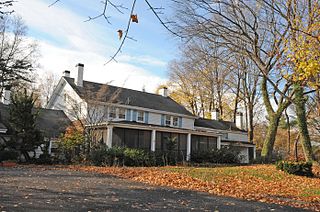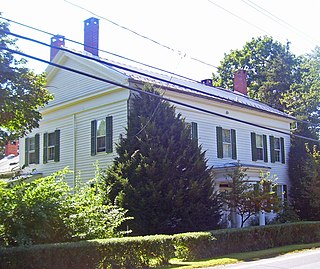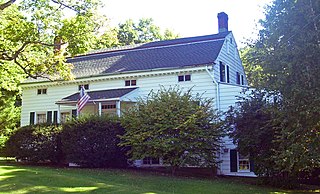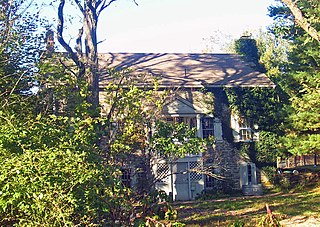
The Thomas McDowell House is located on Lake Road in the Little Britain section of the Town of New Windsor in Orange County, New York, United States. It was built c. 1770 by McDowell, an early settler of the area, and was later rented out by his descendants to prominent local weaver James Alexander. In 2004 it was added to the National Register of Historic Places.

Seven Chimneys, also known as the Nicholas Zabriskie House, was built between 1745 and 1750 by Nicholas Zabriskie, an early Dutch settler in the Hudson Valley. It is the oldest house in Washington Township, Bergen County, New Jersey. Notable visitors include Theodore Roosevelt. The house was used as a stop on the Underground Railroad. Seven Chimneys was placed on the National Register of Historic Places in 1971.

Woodlawn Farm, sometimes known as the Wood Homestead, is located on Mount Orange Road, a short distance north of Slate Hill, New York, United States. It is centered by a three-section farmhouse whose materials date to the mid-18th century, making it one of the oldest buildings in the Town of Wawayanda. In 2008 it was listed on the National Register of Historic Places.

The John Kane House, also one of several places known as Washington's Headquarters, is located on East Main Street in Pawling, New York, United States. Built in the mid-18th century, it was home during that time to two men who confronted the authorities and were punished for it. During the Revolutionary War, George Washington used the house as his headquarters when the Continental Army was garrisoned in the area.

The Abraham Brower House is located at Water and Division streets in New Hamburg, New York, United States. It is a mid-19th century home of one the hamlet's early residents that was added to the National Register of Historic Places in 1987.

Maple Lawn, also known as the Walter Vail House, is a residence in Balmville, New York, United States built in the Gothic Revival architectural style's Picturesque mode. It was designed by Frederick Clarke Withers, following principles of his late mentor, Andrew Jackson Downing, and commissioned by a wealthy local family in 1859.

The Lace House, also known as the Uriah Edwards House, is located on state highway NY 22 in Canaan, New York, United States. It is a frame house built in the early 19th century.

The Cornelius Carman House is located along River Road South in Chelsea, New York, United States. It is a wooden house built in the 1830s, overlooking the Hudson River, for Carman, operator of a local shipyard and inventor of a moveable centerboard.

The Stephen Hogeboom House is located on NY 23B in Claverack, New York, United States. It is a frame Georgian-style house built in the late 18th century.

The Stephen Miller House, also known as the Van Wyck-Miller House, is located along the NY 23 state highway in Claverack, New York, United States. It is a wooden farmhouse dating from the late 18th century.

The C. K. Schoonmaker Stone House is located on Queens Highway near the hamlet of Kerhonkson, New York, United States, in the Ulster County town of Rochester. It is a stone bank house erected in the early 19th century.

The Jacob Hoornbeck Stone House is located at the junction of Boice Mill and Drum Farm roads in Kerhonkson, New York, United States, a hamlet of the Town of Rochester in Ulster County. It was erected in the early 19th century using the Georgian architectural style, incorporating an earlier house as its rear wing.

The Newcomb–Brown Estate is located at the junction of the US 44 highway and Brown Road in Pleasant Valley, New York, United States. It is a brick structure built in the 18th century just before the Revolution and modified slightly by later owners but generally intact. Its basic Georgian style shows some influences of the early Dutch settlers of the region.

The H.R. Stevens House is located on Congers Road in the New City section of the Town of Clarkstown, New York, United States. It is a stone house dating to the late 18th century. In the early 19th century it was expanded with some wood frame upper stories added later. The interior was also renovated over the course of the century.

The Thomas N. Wheeler Farm is located on Indian Lake Road in the Town of North East, New York, United States, south of the village of Millerton. It is a frame house built at the beginning of the 19th century in the Federal style.

The Ezra Clark House is located on Mill Road in the Town of North East, New York, United States. It is a brick house built in the late 18th century.

The Hendrick Martin House is located on Willowbrook Lane in the town of Red Hook, New York, United States, just north of the eponymous village. It is a stone house built in two phases in the mid- and late 18th century. In 2007 it was listed on the National Register of Historic Places.

The Peabody Tavern is a historic traveler's accommodations on United States Route 2 in Gilead, Maine. Built c. 1800 by Thomas Peabody, nephew to one of the area's first white settlers, it served travelers as a stagecoach, and later railroad, stop until the early 20th century. It was listed on the National Register of Historic Places in 1976.

David Faucette House, also known as The Elms and Maude Faucette House, is a historic home located near Efland, Orange County, North Carolina. It was built about 1820, and is a two-story, three bay, gable-roofed, vernacular Federal style frame farmhouse with a rear kitchen wing and side wing added in the 1970s. It sits on a fieldstone foundation and has flanking exterior brick end chimneys. It features a mid to late-19th century hip-roofed front porch with turned posts and sawn brackets.

Church House, also known as the Barrow House, is a historic mansion in Columbia, Tennessee. It was listed on the National Register of Historic Places in 1978. Nominated for the National Register on 10/19/78, The Barrow House, which was built in ca. 1873, is one of the best examples the Second Empire style of architecture in Columbia and one of the grandest late-nineteenth-century houses in the city. Its decidedly three-dimensional massing, profuse ornamentation, and the combination of attached and semi-detached dependencies are distinctive. The façade porch, with its effusive decorative elements, and the bay windows in the east and south elevations emphasize the horizontal lines of the building and in part balance the predominant verticality of the tower and mansard roof. Three blocks west of the court square, the Barrow House is located in a formerly prestigious neighbourhood, an area which still contains a number of large late-nineteenth century houses. The wealthy and prominent of Columbia reside here.
























